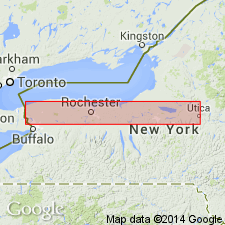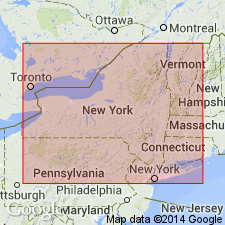
- Usage in publication:
-
- Dawes sandstone
- Modifications:
-
- Named
- Dominant lithology:
-
- Sandstone
- AAPG geologic province:
-
- Appalachian basin
Summary:
Name Dawes sandstone proposed for light-gray slightly calcareous sandstone exposed in town of Kirkland, Oneida Co., NY. Unit is very cross-bedded and unfossiliferous. Contains a few thin layers of arenaceous shales in basal part. Upper part stained red. Thickness about 8 ft. Unconformably underlies Kirkland iron ore; unconformably overlies Willowvale shale. Age is Middle Silurian.
Source: GNU records (USGS DDS-6; Reston GNULEX).

- Usage in publication:
-
- Dawes Formation
- Modifications:
-
- Revised
- AAPG geologic province:
-
- Appalachian basin
Summary:
Newly named Salmon Creek Bed at the base of the Irondequoit Limestone in western NY is correlated with the conglomeratic basal bed of the Dawes Formation in east-central NY. This basal bed of the Dawes has apparently been misidentified as Kirkland Hematite at several localities. Age of the Salmon Creek is Early and Middle Silurian (late Llandoverian and early Wenlockian)
Source: GNU records (USGS DDS-6; Reston GNULEX).
For more information, please contact Nancy Stamm, Geologic Names Committee Secretary.
Asterisk (*) indicates published by U.S. Geological Survey authors.
"No current usage" (†) implies that a name has been abandoned or has fallen into disuse. Former usage and, if known, replacement name given in parentheses ( ).
Slash (/) indicates name conflicts with nomenclatural guidelines (CSN, 1933; ACSN, 1961, 1970; NACSN, 1983, 2005, 2021). May be explained within brackets ([ ]).

